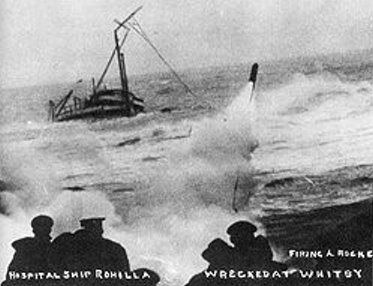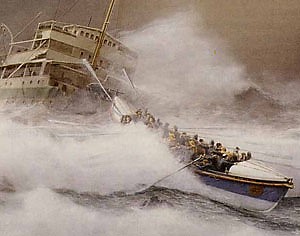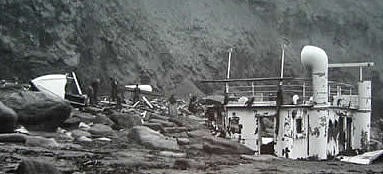HMHS Rohilla Introduction

The SS Rohilla was built and launched by Harland and Wolff shipbuilders in Belfast. Although launched on 6 September 1906, she was not delivered to the British Indian Steam Navigation Co. Ltd until 17 November 1906.
The Rohilla was named after an Afghan tribe who had sought refuge in India during the 18th Century. They were annihilated by the Nawab of Oudh (with the unauthorised help of British troops).
In 1908, the Rohilla entered service as a permanent military ship. On 6 August 1914, she was requisitioned as a hospital ship and became known as the HMHS Rohilla. She was immediately refitted with the necessary equipment and all her passenger accommodation became hospital wards. She was also fitted with two operating theatres.
Whilst on board the HMS Collingwood as a midshipman, Prince Albert (later to be King George V) developed an appendicitis. He travelled on board the Rohilla to Aberdeen which was the nearest medical facility able to treat his condition. Under the command of Captain David Landles Neilson, the Rohilla arrived at the harbour on 29 August 1915. She was too large to enter, so Prince Albert was lifted in a cot by crane into a tug and brought ashore, where royal surgeons met him. On 29 October 1914, the Rohilla set sail for what would be her last voyage carrying 229 people. She began to sail down the East Coast of England. Captain Neilson was unfamiliar with the waters. It was unknown whether there would be enemy submarines or mines in the area. To make matters worse the weather had started to deteriorate. By the time the Rohilla approached the northern side of Whitby, the weather was blowing gale force.
Albert Jefferies, the Whitby Coastguard saw that the course of the Rohilla was heading directly into the rocky coastline (or “Whitby Rock” as it is called). Jefferies tried to signal the Rohilla using Morse code but did not get a response. The crew on board the Rohilla had no idea of the dangers that they were approaching. At 4.00 a.m., the Rohilla struck the rocks near Saltwick Nab, Whitby. Captain Neilson thought that the ship had hit a mine and needed to make an urgent decision how to proceed. He could either run the ship aground trying to save as many lives as possible or he could stop the ship and hope that the gale conditions would not prevent a speedy evacuation. He chose to run the ship aground.
Within a few minutes the ship hit a large wave cut rock with such force that her infrastructure fractured in two places. Before long, the stern section collapsed into deeper waters. Even though only 500 yards away from the shore the Rohilla’s position would prove difficult to access for the rescue services. The gale force winds continued to lash at the ships' side. The coastguard fired rockets to alert the rescue services.
The Rocket Brigade equipped with rockets and a Boson's Chair started the rescue operation. A line was attached to a rocket and fired over the Rohilla for the survivors to catch the line and secure it to something strong. The Boson's chair was then fitted to the line and passengers would be transported one by one to safety. Unfortunately, three rockets were fired but all failed to reach the Rohilla. The Rohilla took quite a pounding from the waves and survivors were slowly being washed over the side of the ship. If this happened, it was very unlikely that they would survive because the waves would dash a person on the rocks killing them instantly. The Rescue Services consisted of six conventional lifeboats including the John Fielden and Robert and Mary Ellis. Unfortunately, they were ineffective because the sea was too rough.
A second attempt was made to rescue another 18 passengers. The lifeboat was severely damaged and was abandoned.
On Saturday, the gale continued to rage. The rescue attempt needed a motorised lifeboat. The nearest one was located at Teesside.
The lifeboat, Henry Vernon, left her home port of Tyneside at 4.15 p.m. It had to sail down the coast to Whitby. It took five and a half hours before one boat reached the doomed ship to rescue only 17 people.HMHS Rohilla entered Military setrvice in 1908


HMHS Rohilla struck rocks near Saltwick Nab, Whitby
The Heroic Rescue of Passengers and Crew





HMHS Rohilla Inquest and Awards
On Saturday 31 October 1914, the coroner, George Buchanan opened the inquest at the Court House, Spring Hill on ten of the bodies recovered. During the course of the week several more inquests were held following the recovery of more bodies. At the first inquest, Captain Neilson and his four senior officers gave evidence. The jury found that in the light of the severity of the storm, absence of lights and usual safeguards, Captain Neilson was not responsible for the disaster. However, it was never explained why the ship was seven miles off course.
The jury recommended that passenger liners should always be supplied with rocket apparatus so that any stricken ship could fire the line to the shore to better guaranteeing being picked up by rescuers. The jury also recommended that a motorised lifeboat should be provided for Whitby.
Superintendent Major H. E. Burton, Coxswain Robert Smith of the Tynemouth lifeboat Henry Vernon and Coxswain Thomas Langlands of the Whitby lifeboat were presented with the highest honour award of the Gold Medal from the Royal National Lifeboat Institution.
A monument was erected by the British India Steam Navigation Company in 1917 to commemorate the tragedy.
On the centenary a plaque, funded by Whitby Civic Society, was laid on the West Pier facing the site of the wreck on Saturday 1st November 2014.
